5 books about Civilians
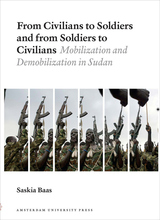
From Civilians to Soldiers and from Soldiers to Civilians
Mobilization and Demobilization in Sudan
Saskia Baas
Amsterdam University Press, 2012
Drawing on extensive research and personal accounts, this hard-hitting study investigates the processes of mobilization and demobilization of fighters from all factions during the long, drawn out civil war in Sudan. Through in-depth interviews with current and former combatants in Sudan Saskia Baas investigates how civilians get drawn into the conflict and what the deep consequences are for becoming part of a guerilla movement. The resulting narrative is fascinating and disturbing, while providing vivid insight into the dynamics of civil war that are relevant to conflicts all over the world. From Civilians to Soldiers and from Soldiers to Civilians will appeal to political scientists, military historians, and nonacademic audiences interested in the conflict in Sudan.
[more]
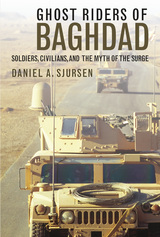
Ghost Riders of Baghdad
Soldiers, Civilians, and the Myth of the Surge
Daniel A. Sjursen
University Press of New England, 2015
From October 2006 to December 2007, Daniel A. Sjursen—then a U.S. Army lieutenant—led a light scout platoon across Baghdad. The experiences of Ghost Rider platoon provide a soldier’s-eye view of the incredible complexities of warfare, peacekeeping, and counterinsurgency in one of the world’s most ancient cities. Sjursen reflects broadly and critically on the prevailing narrative of the surge as savior of America’s longest war, on the overall military strategy in Iraq, and on U.S. relations with ordinary Iraqis. At a time when just a handful of U.S. senators and representatives have a family member in combat, Sjursen also writes movingly on questions of America’s patterns of national service. Who now serves and why? What connection does America’s professional army have to the broader society and culture? What is the price we pay for abandoning the model of the citizen soldier? With the bloody emergence of ISIS in 2014, Iraq and its beleaguered, battle-scarred people are again much in the news. Unlike other books on the U.S. war in Iraq, Ghost Riders of Baghdad is part battlefield chronicle, part critique of American military strategy and policy, and part appreciation of Iraq and its people. At once a military memoir, history, and cultural commentary, Ghost Riders of Bahdad delivers a compelling story and a deep appreciation of both those who serve and the civilians they strive to protect. Sjursen provides a riveting addition to our understanding of modern warfare and its human costs.
[more]
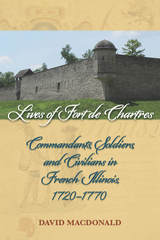
Lives of Fort de Chartres
Commandants, Soldiers, and Civilians in French Illinois, 1720–1770
David MacDonald
Southern Illinois University Press, 2016
Winner, ISHS Annual Award for a Scholarly Publication, 2017
Fort de Chartres, built in 1719-1720 in the heart of what would become the American Midwest, embodied French colonial power for half a century. Lives of Fort de Chartres, by David MacDonald, details the French colonial experience in Illinois from 1720 to 1770 through vivid depictions of the places, people, and events around the fort and its neighboring villages.
In the first section, MacDonald explores the fascinating history of French Illinois and the role of Fort de Chartres in this history, focusing on native peoples, settlers, slaves, soldiers, villages, trade routes, military administration, and the decline of French rule in Illinois. The second section profiles the fort’s twelve distinctive and often colorful commandants, who also served as administrative heads of French Illinois. These men’s strong personalities served them well when dealing simultaneously with troops, civilians, and Indians and their multifaceted cultures. In the third section, MacDonald presents ten thought-provoking biographies of people whose lives intersected with Fort de Chartres in various ways, from a Kaskaskia Indian woman known as “the Mother of French Illinois” to an ill-fated chicken thief and a European aristocrat. Subjects treated in the book include French–Native American relations, the fur trade, early Illinois agriculture, and tensions among different religious orders. Together, the biographies and historical narrative in the volume illuminate the challenges that shaped the French colonies in America.
The site of Fort de Chartres, recognized as a National Historic Landmark in 1966, still exists today as a testament to the ways in which French, British, Spanish, and American histories have intertwined. Both informative and entertaining, Lives of Fort de Chartres contributes to a more complete understanding of the French colonial experience in the Midwest and portrays a vital and vigorous community well worth our appreciation.
Fort de Chartres, built in 1719-1720 in the heart of what would become the American Midwest, embodied French colonial power for half a century. Lives of Fort de Chartres, by David MacDonald, details the French colonial experience in Illinois from 1720 to 1770 through vivid depictions of the places, people, and events around the fort and its neighboring villages.
In the first section, MacDonald explores the fascinating history of French Illinois and the role of Fort de Chartres in this history, focusing on native peoples, settlers, slaves, soldiers, villages, trade routes, military administration, and the decline of French rule in Illinois. The second section profiles the fort’s twelve distinctive and often colorful commandants, who also served as administrative heads of French Illinois. These men’s strong personalities served them well when dealing simultaneously with troops, civilians, and Indians and their multifaceted cultures. In the third section, MacDonald presents ten thought-provoking biographies of people whose lives intersected with Fort de Chartres in various ways, from a Kaskaskia Indian woman known as “the Mother of French Illinois” to an ill-fated chicken thief and a European aristocrat. Subjects treated in the book include French–Native American relations, the fur trade, early Illinois agriculture, and tensions among different religious orders. Together, the biographies and historical narrative in the volume illuminate the challenges that shaped the French colonies in America.
The site of Fort de Chartres, recognized as a National Historic Landmark in 1966, still exists today as a testament to the ways in which French, British, Spanish, and American histories have intertwined. Both informative and entertaining, Lives of Fort de Chartres contributes to a more complete understanding of the French colonial experience in the Midwest and portrays a vital and vigorous community well worth our appreciation.
[more]
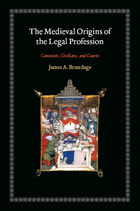
The Medieval Origins of the Legal Profession
Canonists, Civilians, and Courts
James A. Brundage
University of Chicago Press, 2008
In the aftermath of sixth-century barbarian invasions, the legal profession that had grown and flourished during the Roman Empire vanished. Nonetheless, professional lawyers suddenly reappeared in Western Europe seven hundred years later during the 1230s when church councils and public authorities began to impose a body of ethical obligations on those who practiced law. James Brundage’s The Medieval Origins of the Legal Profession traces the history of legal practice from its genesis in ancient Rome to its rebirth in the early Middle Ages and eventual resurgence in the courts of the medieval church.
By the end of the eleventh century, Brundage argues, renewed interest in Roman law combined with the rise of canon law of the Western church to trigger a series of consolidations in the profession. New legal procedures emerged, and formal training for proctors and advocates became necessary in order to practice law in the reorganized church courts. Brundage demonstrates that many features that characterize legal advocacy today were already in place by 1250, as lawyers trained in Roman and canon law became professionals in every sense of the term. A sweeping examination of the centuries-long power struggle between local courts and the Christian church, secular rule and religious edict, The Medieval Origins of the Legal Profession will be a resource for the professional and the student alike.
By the end of the eleventh century, Brundage argues, renewed interest in Roman law combined with the rise of canon law of the Western church to trigger a series of consolidations in the profession. New legal procedures emerged, and formal training for proctors and advocates became necessary in order to practice law in the reorganized church courts. Brundage demonstrates that many features that characterize legal advocacy today were already in place by 1250, as lawyers trained in Roman and canon law became professionals in every sense of the term. A sweeping examination of the centuries-long power struggle between local courts and the Christian church, secular rule and religious edict, The Medieval Origins of the Legal Profession will be a resource for the professional and the student alike.
[more]
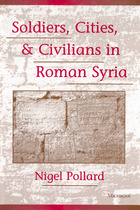
Soldiers, Cities, and Civilians in Roman Syria
Nigel Pollard
University of Michigan Press, 2000
When one mentions "empire," one place probably comes to mind: Rome. The Romans conquered an empire that covered almost the complete extent of their known world. With a territory that large, there was, of course, a huge cultural diversity between the different corners of the empire. How could the central authority in Rome bring together all the different cultures, religions and customs under one administrative umbrella? Soldiers, Cities and Civilians in Roman Syria explores some of the interactions between the imperial authority and the subjected peoples in the territory of Syria. It looks at how the imperial power controlled its subjects, how the agents of the imperial power (administrators, soldiers, etc.) interacted with those subjects, and what impact the imperial power had on the culture of ruled territories. The Roman empire had few civilian administrators, so soldiers were the representatives of imperial government to be encountered by many provincial civilians. Soldiers, Cities and Civilians in Roman Syria employs the evidence of Roman texts and documents and modern archaeological excavation as well as "alternative" sources, such as the literature of the subject peoples and informal texts such as graffiti, to examine the relationship between soldiers and civilians in the important frontier province of Syria.
Nigel Pollard is currently a Research Assistant at the Institute of Archaeology, University of Oxford.
Nigel Pollard is currently a Research Assistant at the Institute of Archaeology, University of Oxford.
[more]
READERS
Browse our collection.
PUBLISHERS
See BiblioVault's publisher services.
STUDENT SERVICES
Files for college accessibility offices.
UChicago Accessibility Resources
home | accessibility | search | about | contact us
BiblioVault ® 2001 - 2024
The University of Chicago Press









